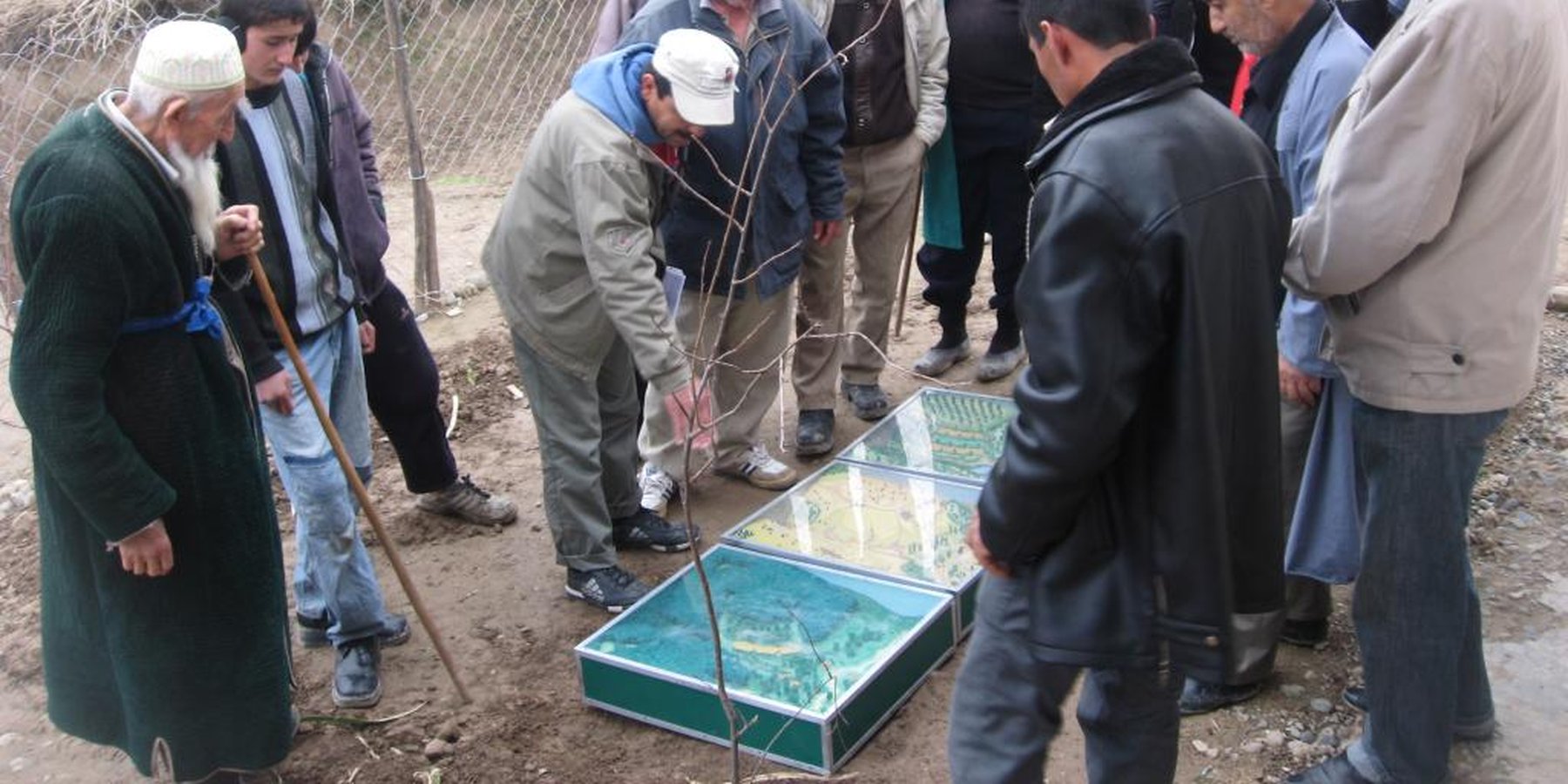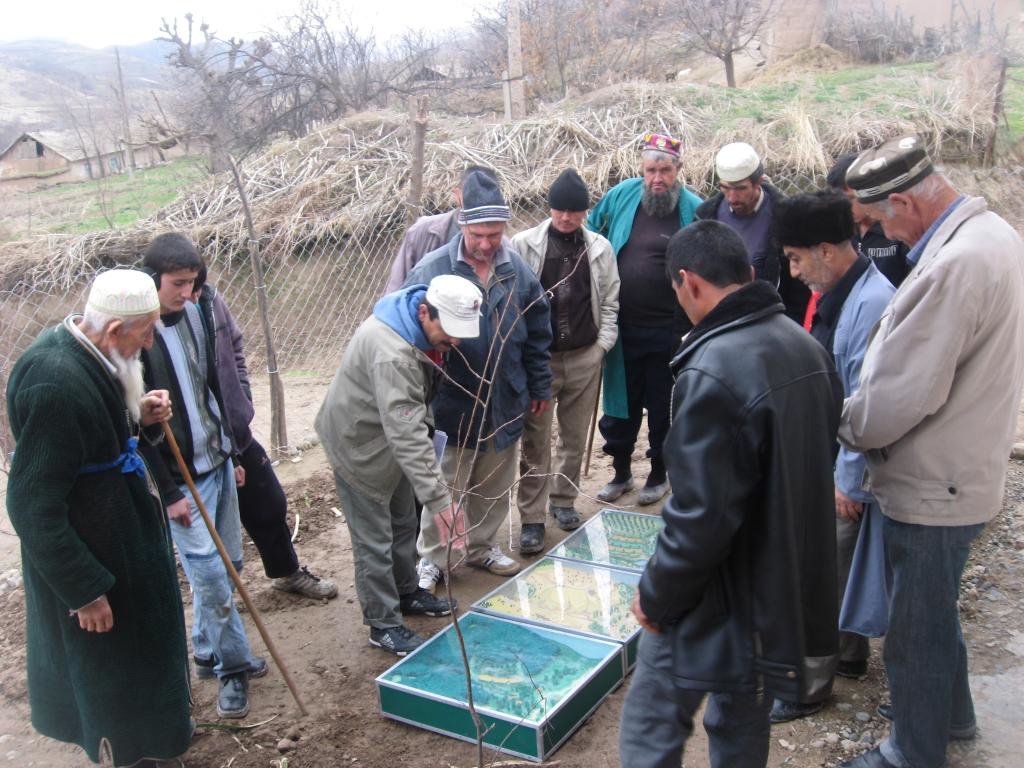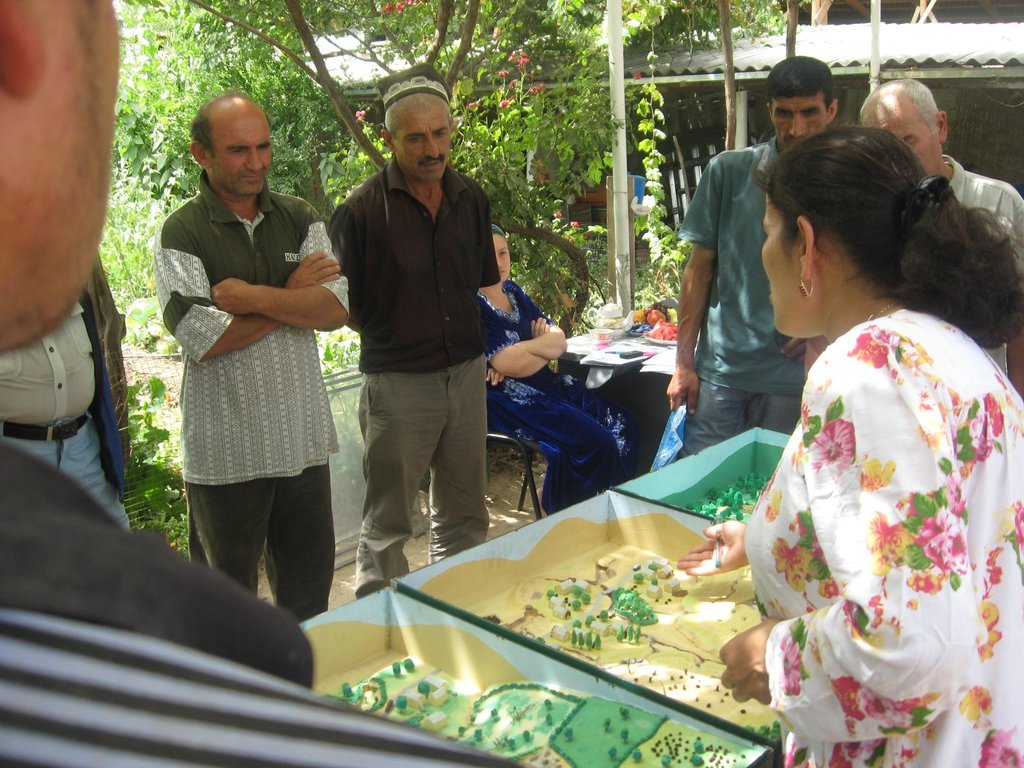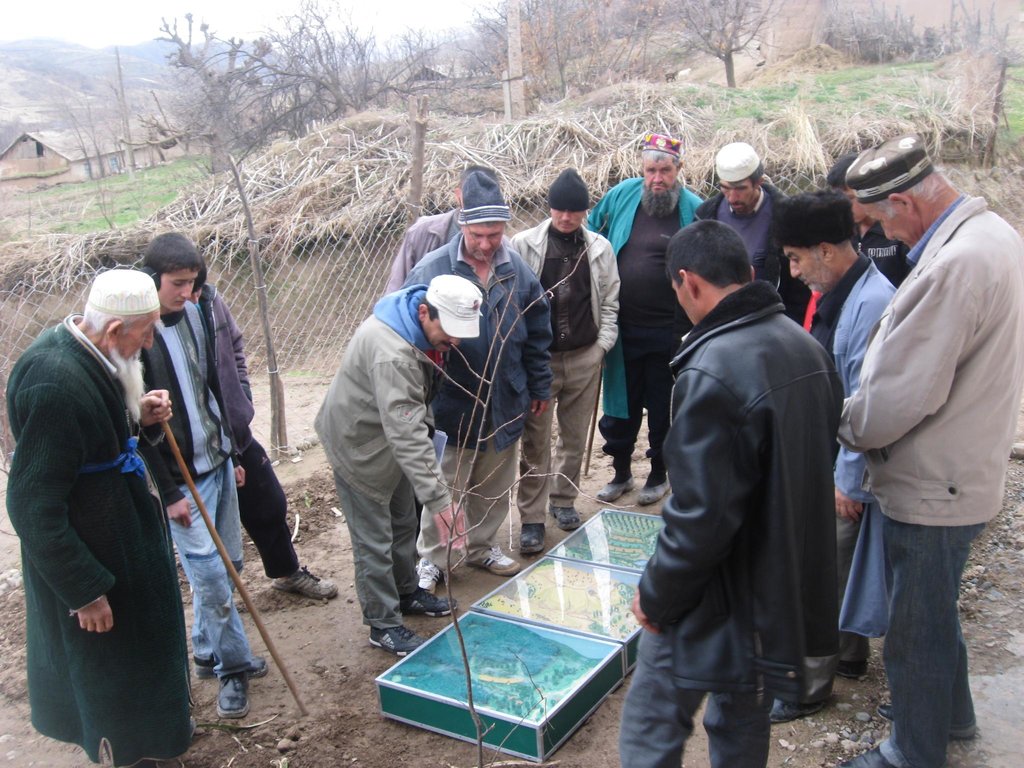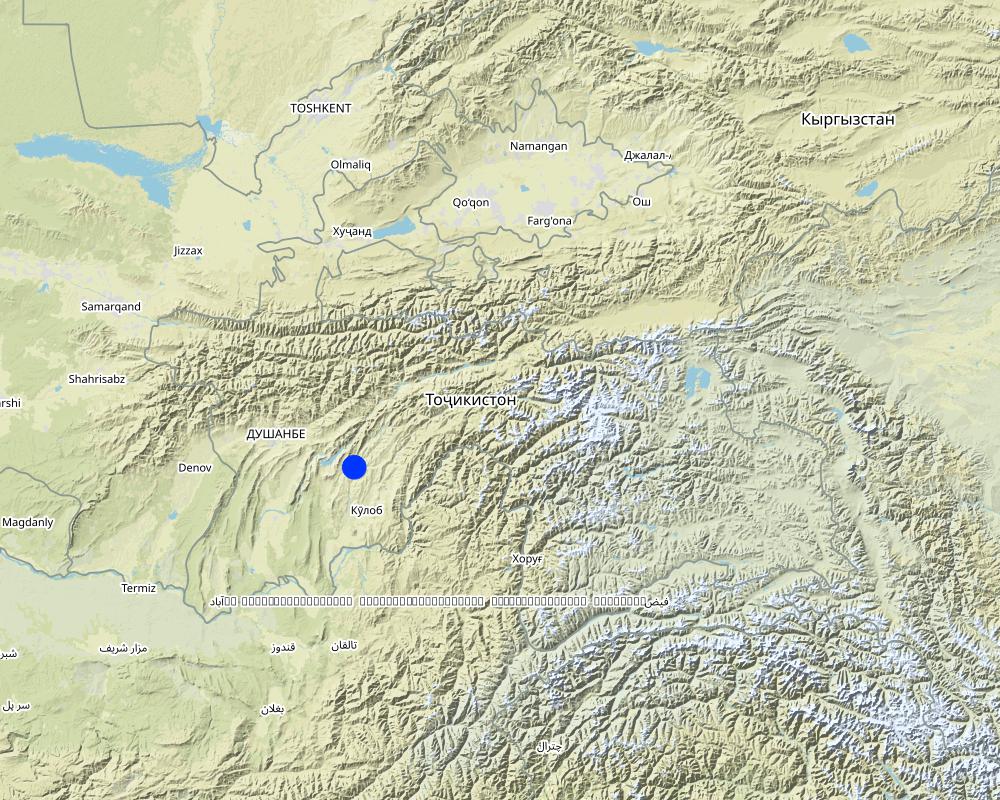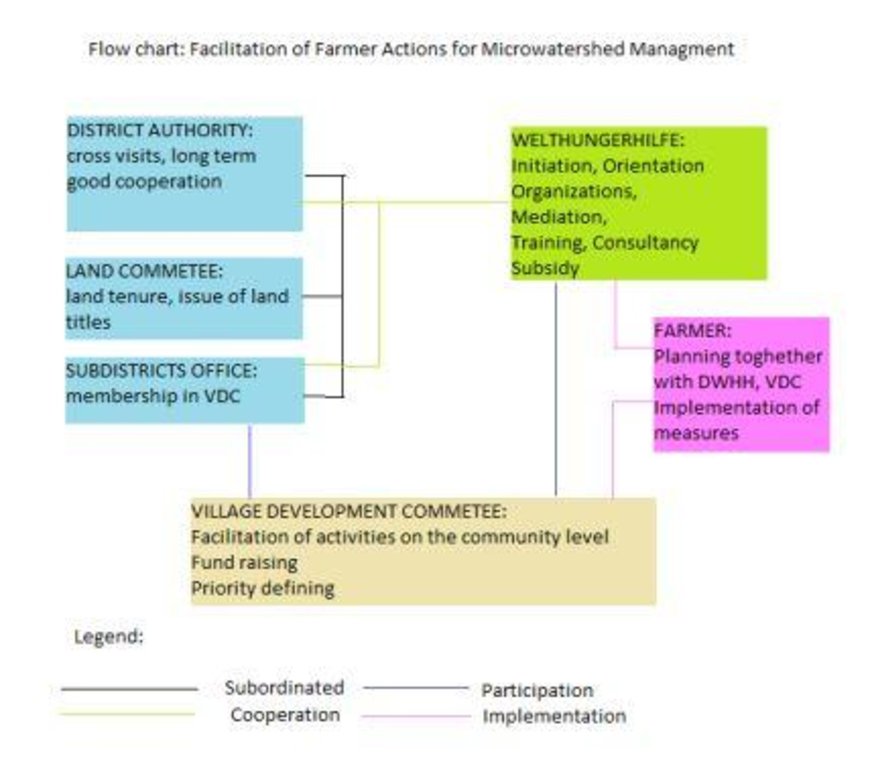Facilitation of micro-watershed management for farmers [Tajiquistão]
- Criação:
- Atualização:
- Compilador/a: Manuchehr Rakhmatdzhonov
- Editor: –
- Revisores: David Streiff, Alexandra Gavilano, Joana Eichenberger
Фасилитасияи амалиётхои дехкон барои идораи микрохавза
approaches_2443 - Tajiquistão
Veja as seções
Expandir tudo Recolher tudo1. Informação geral
1.2 Detalhes do contato das pessoas capacitadas e instituições envolvidas na avaliação e documentação da abordagem
Especialista em GST:
Especialista em GST:
Especialista em GST:
Bronkal Daniel
daniel.bronkal@welthungerhilfe.de
Alemanha
Nome do projeto que facilitou a documentação/avaliação da Abordagem (se relevante)
Pilot Program for Climate Resilience, Tajikistan (WB / PPCR)Nome da(s) instituição(ões) que facilitou(ram) a documentação/avaliação da Abordagem (se relevante)
Deutsche Welthungerhilfe (Welthungerhilfe) - Tajiquistão1.3 Condições em relação ao uso da informação documentada através de WOCAT
O/a compilador/a e a(s) pessoa(s) capacitada(s) aceitam as condições relativas ao uso de dados documentados através da WOCAT:
Sim
1.4 Referência ao(s) questionário(s) sobre tecnologias da GST
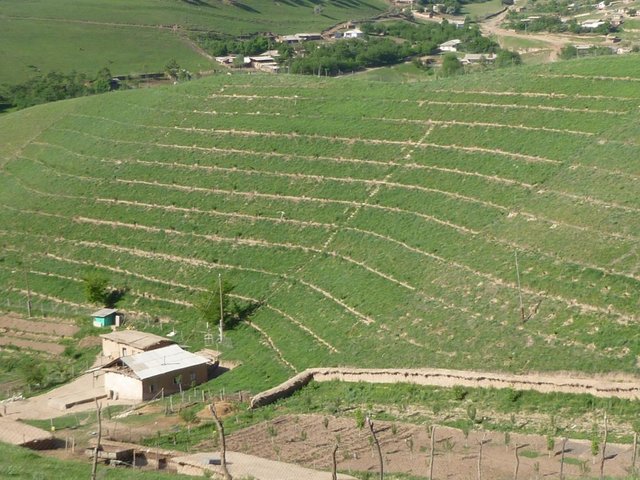
Gradual development of bench terraces from contour ditches [Tajiquistão]
Use of the SLM technology facilitates the development of bench terraces from contour channels by gradually removing soil material up the slope for an estimated 5 years until the terraces on the slope reach a desired width of 1.2 m.
- Compilador/a: Manuchehr Rakhmatdzhonov
2. Descrição da abordagem de GST
2.1 Descrição curta da abordagem
Relying on integrated watershed management principles, farmers were assisted by the project to implement soil and water conservation measures in a microwatershed.
2.2 Descrição detalhada da abordagem
Descrição detalhada da abordagem:
Aims / objectives: To strengthen the capacity of the community to plan and implement integrated natural resource management approaches, at micro watershed level in sustainable ways. These include; conserving soil by introducing actions to rehabilitate the eroded land, stop gully formation resulting from water run-off; enable water retention to secure soil moisture for a longer time period; mitigate effects of overstocking resulting in overgrazing; hoof erosion and soil compaction; reverse inappropriate agriculture practices towards more efficient and environmentally friendly management types; enable better employment and higher income generation to improve the livelihood standards and food security.
Methods: The project facilitated the following activities: Farmer participation, and using their initiative, community involvement in the planning, fundraising and implementation. Farmers increased their own contribution for material inputs, and a greater than 50% rate of adoption of the innovation was seen. The project also funded 'on the job' training, technical support, consultancy, and mediation of communication between parties.
Stages of implementation: 1. Awareness raising, 2. On the job training, 3. Watershed management activity planning, 4. Implementation, 5. Monitoring, 6. Evaluation, 7. Readjustment based on results, 8. Further replication in new area
Role of stakeholders: The DWHH Project had a leading role in initiation, orientation, awareness raising, mobilisation, training, consultancy, input provision and mediation of communication to land committee. Farmers have been actively participating, have provided labour input / financial contribution, provided indigenous knowledge and skills. Local authorities - providing land titles, participation in planning and decision making process Village Development Committee (VDC) - community mobilisation, information dissemination, input / finance documentation, fund raising.
Other important information: There are 5 households in the microwatershed. Almost 40 people live in all HH, all are Tajiks. Members of all households took part in discussion rounds and training. Non of HHs were strong enough to implement measures on own funds. One HH has rejected implementation of measures, due lack of capacity and lack of trust of the project's success. Women: farmers came to the discussions together with their wives, women took part in training, in implementing almost all of the adoption measures, and equally benefited from the project. However, they were not involved in decision making.
2.3 Fotos da abordagem
2.5 País/região/locais onde a abordagem foi aplicada
País:
Tajiquistão
Região/Estado/Província:
Tajikistan, Khatlon
Especificação adicional de localização:
Baljuvon / Khirob
Map
×2.6 Datas de início e término da abordagem
Indique o ano de início:
2009
Ano de término (caso a abordagem não seja mais aplicada):
2011
2.7 Tipo de abordagem
- Iniciativa/inovação local recente
2.8 Principais metas/objetivos da abordagem
The Approach focused mainly on SLM with other activities ( land use change, resource conservation, capacity building, focus on low cost local material, income generation, on the job training)
To assist farmers in the planning and implementation of activities for the conservation and improvement of the local land, to enable conditions for replication of the approach/technology, and to improve food production, and in the long run provide income generation.
The SLM Approach addressed the following problems: Lack of land tenure rights implementation. Nominal state farm reorganisation. Low agricultural production - lands depleted of nutrients, very low yields, no crop rotation, overgrazing. Soil degradation, progressing land mass transport, gully formation. Lack of technical knowledge and awareness of soil & water conservation measures. Lack of cash to invest in development of land - just limited capacity to invest but need external financial input. Conflict over land use - livestock owners are against land enclosures. Poverty - underlying cause of general lack of potential to invest in development.
2.9 Condição que propiciam ou inibem a implementação de tecnologia/tecnologias aplicada(s) segundo a abordagem
Disponibilidade/acesso a recursos e serviços financeiros
- Inibitivo
Technology implementation has required a major investment for imported materials, like a metal net for fencing or fuel. Most farmers could not afford themselves to buy costly inputs. Moreover such inputs were rarely available on the local market.
Treatment through the SLM Approach: The INGO covered the costs of 50% of each action, here mainly higher price inputs were paid off. The low-cost approach fits the financial capacity of the target group.
Quadro institucional
- Inibitivo
Capacities of communities and local authorities to jointly plan and implement SLM activities at micro-watershed level was weak.
Treatment through the SLM Approach: Knowledge improved on the complex interrelations in natural ecosystems (farmers and staff of local authorities). Project cooperation was not limited to those interested, there was inclusion of gov. structures (agriculture, land committee, ecology) committ
Quadro jurídico (posse de terra, direitos de uso da terra e da água)
- Propício
The existing land ownership, land use rights / water rights moderately helped the approach implementation: On going legislative development in land tenure and farming provides good opportunities for implementation of the approach. But, ongoing nominal farm reorganisation and corruption at the local level, together with farmers reduced awareness of their land use rights requires more effort, time and funds in the application of SLM approaches. In this situation, DWHH has a good reputation in the district administration and with locals and so this helped overcome many barriers more easily.
- Inibitivo
Implementing the land tenure law and the privatisation of state farms is still a difficult process with many inconsistencies for people claiming a land title in the area.
Treatment through the SLM Approach: There are a few instances where the project was able to support farmers in getting land-titles to degraded land plots which they then had to rehabilitate using SLM technologies.
Conhecimento sobre GST, acesso a suporte técnico
- Inibitivo
Treatment through the SLM Approach:
3. Participação e papel das partes interessadas envolvidas
3.1 Partes interessadas envolvidas na abordagem e seus papéis
- Usuários de terra/comunidades locais
Village Development Committee, farmers
Men have played bigger role in the organisation of activities, in the implementation of more manual work, whereas, women took part in the lighter work and in routine maintenance.
Most of the participating households live below the poverty line.
Farmers joined under one microwatershed approach, male (wife assisted), middle age, Tajiks, rural middle class.
- Especialistas em GST/ consultor agrícola
Project TAJ1068 staff, and an international consultant
- Organização não governamental
Deutsche Welthungerhilfe
- Governo local
Subdistrict, District Heads, Agriculture, Land committees, Forestry department
3.2 Envolvimento do usuários de terra/comunidades locais nas diferentes fases da abordagem
| Envolvimento do usuários de terra/comunidades locais | Especifique quem estava envolvido e descreva as atividades | |
|---|---|---|
| Iniciação/motivação | Participativo | farmers meeting through VDC, orientation explaining goals, objectives, advertising in the local news paper, information boards in 6 watersheds |
| Planejamento | Participativo | on site planning with farmers |
| Implementação | Participativo | training on the job, material input and labour provision, cross visits |
| Monitoramento/avaliação | Participativo | data input, open to monitoring, communication on ongoing activities, collaboration while monitoring and evaluation |
| Research | Participativo | collaboration in the test for Acacia seed germination on the plot |
3.3 Fluxograma (se disponível)
Descrição:
Flow chart depicts the major actors involved during implementation of the approach. The relationship between stakeholders and primary functions is described as well.
Autor:
Manuchehr Rakhmatdzhonov (16, Firdavsi Street 734003, Dushanbe)
3.4 Decisão sobre a seleção de tecnologia/tecnologias de GST
Especifique quem decidiu sobre a seleção de tecnologia/tecnologias a serem implementadas:
- Principalmente especialistas em GST, após consulta com usuários da terra
Explique:
Decisions on the method of implementing the SLM Technology were made by mainly by SLM specialists with consultation of land users. Focused on principles of farmer participation, self motivation and self help.
4. Suporte técnico, reforço das capacidades e gestão do conhecimento
4.1 Reforço das capacidades/ formação
Foi oferecida formação aos usuários da terra/outras partes interessadas?
Sim
Especifique quem foi capacitado:
- Usuários de terra
- Equipe de campo/consultores
- local land and agriculture departments, village development committee
Caso seja relevante, especifique gênero, idade, status, etnia, etc.
Land users: 5 men, 5 women, 30 to 50 years old, all Tajiks, all families.
Tipo de formação:
- Em exercício
- Áreas de demonstração
- Reuniões públicas
Assuntos abordados:
Use of the A-frame, watershed model, tree planting in contour ditches, intercropping
4.2 Serviço de consultoria
Os usuários de terra têm acesso a um serviço de consultoria?
Sim
Especifique se foi oferecido serviço de consultoria:
- nas áreas dos usuários da terra
Descreva/comentários:
A chain of meetings with international consultants from India and Nepal: Key elements: consultation on watershed concepts and watershed choice, capacity building in strategy design , draft development plan for watershed management
The consultants were : Yashvant Tkhakur, India; Jaganat Joschi, Nepal
Advisory service is inadequate to ensure the continuation of land conservation activities; the govenment branches need more development and organisation to become able to manage land conservation activities; an independent advisory service is not in place, the only potential still exists within the DWHH Project
4.3 Fortalecimento da instituição (desenvolvimento organizacional)
As instituições foram fortalecidas ou estabelecidas através da abordagem?
- Sim, pouco
Especifique a que nível (níveis) as instituições foram fortalecidas ou estabelecidas:
- Local
Especifique o tipo de apoio:
- Reforço das capacidades/ formação
Dê mais detalhes:
Village development committee (VDC), use of locally available resources, focus on low cost
4.4 Monitoramento e avaliação
Monitoramento e avaliação são partes da abordagem?
Sim
Comentários:
area treated aspects were ad hoc monitored by land users through observations; indicators: space used for technology
economic / production aspects were regular monitored by project staff through measurements; indicators: fodder produced cent/ha, vegetables
socio-cultural aspects were ad hoc monitored by project staff through observations; indicators: labour availability, health status
technical aspects were ad hoc monitored by project staff through observations; indicators: tree planting
bio-physical aspects were ad hoc monitored by project staff through observations; indicators: soil degradation, gully formation
no. of land users involved aspects were ad hoc monitored by project staff through observations; indicators: monthly trends, how hardworking they were, gender
management of Approach aspects were ad hoc monitored by land users through observations; indicators: technology adaptation based on own experience
There were no changes in the Approach as a result of monitoring and evaluation: None
There were few changes in the Technology as a result of monitoring and evaluation: Change of the design - adjustment of the contour boundary based on experience on the plot; Adjusting of tree planting in contour ditches according to the topography
4.5 Pesquisa
A pesquisa foi parte da abordagem?
Sim
Especifique os tópicos:
- Tecnologia
Dê mais detalhes e indique quem realizou a pesquisa:
Tests were completed on the germination of Acacia seeds in two different setups: on the demo plot of the project and on the farmers plot.
Research was carried out both on station and on-farm
5. Financiamento e apoio material externo
5.1 Orçamento anual para o componente de GST da abordagem
Caso o orçamento exato seja desconhecido, indique a faixa:
- 2.000-10.000
Comentários (p. ex. principais fontes de recursos/principais doadores):
Approach costs were met by the following donors: international non-government (material input: tools, fencing, planting material, diesel. etc.): 50.0%; local community / land user(s) (the rest of material input, labour, time (mainly low cost inputs)): 50.0%; other
5.2 Apoio financeiro/material concedido aos usuários da terra
Os usuários da terra receberam apoio financeiro/material para a implementação de tecnologia/tecnologias?
Sim
Caso afirmativo, especifique tipo(s) de apoio, condições e fornecedor(es):
50% of activities were subsidised by the DWHH Project TAJ1068
5.3 Subsídios para entradas específicas (incluindo mão-de-obra)
- Equipamento
| Especifique quais entradas foram subsidiadas | Em que medida | Especifique os subsídios |
|---|---|---|
| Ferramentas | Parcialmente financiado | hand tools |
- Agrícola
| Especifique quais entradas foram subsidiadas | Em que medida | Especifique os subsídios |
|---|---|---|
| Sementes | Parcialmente financiado | |
| manure | Parcialmente financiado | |
- Construção
| Especifique quais entradas foram subsidiadas | Em que medida | Especifique os subsídios |
|---|---|---|
| metal net | Totalmente financiado | |
- Infraestrutura
| Especifique quais entradas foram subsidiadas | Em que medida | Especifique os subsídios |
|---|---|---|
| Escolas | Parcialmente financiado | school, 2 rooms thermo insulated |
- Outro
| Outros (especifique) | Em que medida | Especifique os subsídios |
|---|---|---|
| Fuel, diesel, oil | Parcialmente financiado | 1/4 of the need |
Se a mão-de-obra pelos usuários da terra foi uma entrada substancial, isso foi:
- Voluntário
Comentários:
Rennovation of the chool for the children was a strong and vital argument demanding considerable investment. This was competed with the implementation of the SLM technology, where farmers had to make a choice; either spend the available funds for the school or continue with the SLM. The project has provided partial financial and technology support to farmers which made it easy to overcome the school situation and concentrate again on SLM activities.
5.4 Crédito
Foi concedido crédito segundo a abordagem para atividades de GST?
Não
5.5 Outros incentivos ou instrumentos
Foram utilizados outros incentivos ou instrumentos para promover a implementação das tecnologias de GST?
Sim
Caso afirmativo, especifique:
Village development committee (VDC), use of locally available resources, focus on low cost
6. Análise de impactos e declarações finais
6.1 Impactos da abordagem
A abordagem auxiliou os usuários da terra a implementar e manter as tecnologias de GST?
- Não
- Sim, pouco
- Sim, moderadamente
- Sim, significativamente
Most of the previous types of damage caused by water runoff were prevented. Trees grew in a landscape where they didn't before, due to long dry periods and high livestock pressure from grazing. There was a change in the farmer's attitudes, who prior to witnessing the technology were highly sceptical
A abordagem concedeu autonomia aos grupos social e economicamente desfavorecidos?
- Não
- Sim, pouco
- Sim, moderadamente
- Sim, significativamente
Only four families out of five in the microwatershed were able to receive the opportunity to improve their socio-economic status in the long term as a result of the project.
A abordagem melhorou as questões de posse de terra/diretos do usuário que inibiam a implementação das tecnologias de GST?
- Não
- Sim, pouco
- Sim, moderadamente
- Sim, significativamente
The approach has added to the farmers self belief, ensured that they will effectively use existing land resources, and following the sustainable improvement of soil conditions, should add good potential for their own economic growth.
Did other land users / projects adopt the Approach?
- Não
- Sim, pouco
- Sim, moderadamente
- Sim, significativamente
Farmers from the neighbouring watershed, came repeatedly to observe the plot. Three of these farmers adopted the technology themselves in the following year.
Did the Approach lead to improved livelihoods / human well-being?
- Não
- Sim, pouco
- Sim, moderadamente
- Sim, significativamente
Vegetables could be grown to supply more food to the family, a good amount of hay could be prepared for winter time, more benefits could be seen in the long run with extra fruits and fire wood
Did the Approach help to alleviate poverty?
- Não
- Sim, pouco
- Sim, moderadamente
- Sim, significativamente
This was a pilot project, and only looked at poverty alleviation on a small scale. This technology has the potential to reduce poverty in the long term on a bigger scale.
6.2 Principal motivação dos usuários da terra para implementar a GST
- Produção aumentada
- Lucro (lucrabilidade) aumentado, melhora da relação custo-benefício
- Carga de trabalho reduzida
- Pagamentos/subsídios
- Consciência ambiental
- well-being and livelihoods improvement
6.3 Atividades de sustentabilidade de abordagem
Os usuários da terra podem manter o que foi implementado através da abordagem (sem apoio externo)?
- Sim
Caso afirmativo, descreva como:
Yes, but only those who would have enough funds to implement costliest part of technology: the perimeter fencing (metal net). Overall, most farmers will happily continue with the implementation of the technology, if the initial costs are subsidised. There are also a few new farmers who were able to replicate the technology completely by themselves.
6.4 Pontos fortes/vantagens da abordagem
| Pontos fortes/vantagens/oportunidades na visão do usuário da terra |
|---|
| The approach to share the implementation costs, consideration of general social needs, good project communication. (How to sustain/ enhance this strength: More donor funding would be required to support more local farmers in the future. ) |
| The approach has enabled a range of innovations that were never used before: contour lines, mulching etc. |
| The approach has helped to reveal the local problems related to technology implementation. It has helped participants to learn about the strength and potential of local land users in the implementation of the SLM approach and technology. (How to sustain/ enhance this strength: Lessons learned must be applied in the future implementation of SLM actions and replication. ) |
| Pontos fortes/vantagens/oportunidades na visão do/a compilador/a ou de outra pessoa capacitada |
|---|
| The approach enabled the use of both international and local knowledge. Attention was given to capacity building and sustaining the organisation, as well as the mobilisation structure (VDC) at the grass roots level. (How to sustain/ enhance this strength: All the knowledge experience gained from the project has to be documented and disseminated for replication.) |
| The reputation of DWHH, and long term collaboration with the Baljuvon district administration played a very positive role in the successful implementation of the conservation approach. (How to sustain/ enhance this strength: Members of the local authority should be continuously involved in training, capacity building and planning measures. ) |
6.5 Pontos fracos, desvantagens da tecnologia e formas de superá-los
| Pontos fracos/desvantagens/riscos na visão do usuário da terra | Como eles podem ser superados? |
|---|---|
| Sometimes the approach enabled unproductive discussions during the planning and designing phases. | Project ambitions and objectives have to be adjusted to the local situation and farmer capacity and needs. |
| Farmers were facing situations where their other social and economic needs were strongly competing with the objectives of the project. | Some additional funds, may need to be provided and more awareness of the farmer's situations need to be taken into account. |
| Pontos fracos/vantagens/riscos na visão do/a compilador/a ou de outra pessoa capacitada | Como eles podem ser superados? |
|---|---|
| The approach required a lot of funding until the majors actors were trained and had the capacity to implement the conservation measures. |
7. Referências e links
7.1 Métodos/fontes de informação
- visitas de campo, pesquisas de campo
- entrevistas com usuários de terras
7.2 Referências às publicações disponíveis
Título, autor, ano, ISBN:
Grant Application Form to EU Commission: 'Individual incomes & Improving Living Standarts in Khatlon and Sughd Regions', TajikistanSketch map of Khirob MicrowatershedInterim Narrative Report 01.05.2009-30.04.2010 Project TAJ 1068
Disponível de onde? Custos?
DWHH Regional Office, Dushanbe
Título, autor, ano, ISBN:
Sketch map of Khirob Microwatershed
Disponível de onde? Custos?
DWHH, Baljuvon
Título, autor, ano, ISBN:
Interim Narrative Report 01.05.2009-30.04.2010 Project TAJ 1068
Disponível de onde? Custos?
DWHH, Baljuvon
Links e módulos
Expandir tudo Recolher tudoLinks

Gradual development of bench terraces from contour ditches [Tajiquistão]
Use of the SLM technology facilitates the development of bench terraces from contour channels by gradually removing soil material up the slope for an estimated 5 years until the terraces on the slope reach a desired width of 1.2 m.
- Compilador/a: Manuchehr Rakhmatdzhonov
Módulos
Não há módulos


